Factors influencing tobacco quitting: findings from National Tobacco-Quitline Services, Mumbai, India
Atul Budukh1,2,a, Sharyu Mhamane1,b, Sonali Bagal1,c, Priyal Chakravarti1,d, Ganesh Ogale1,e, Radhika Sharma1,f, Manisha Yadav1,g, Sushama Saoba1,h, Suvarna Gore1,i and Pankaj Chaturvedi2,3,j
1Centre for Cancer Epidemiology (ACTREC), Tata Memorial Centre, Navi Mumbai 410210, India
2Homi Bhabha National Institute, Training School Complex, Anushaktinagar, Mumbai 400094, India
3Advanced Centre for Treatment, Research and Education in Cancer (ACTREC), Tata Memorial Centre, Navi Mumbai 410210, India
ahttps://orcid.org/0000-0001-6723-802X
bhttps://orcid.org/0000-0002-7406-8134
chttps://orcid.org/0000-0002-2510-1751
dhttps://orcid.org/0000-0003-2163-796X
ehttps://orcid.org/0009-0002-0610-4292
fhttps://orcid.org/0009-0007-2155-4220
ghttps://orcid.org/0009-0002-8774-6739
hhttps://orcid.org/0000-0002-4922-8327
ihttps://orcid.org/0000-0002-2866-5480
jhttps://orcid.org/0000-0002-3520-1342
Abstract
The Government of India established National Tobacco Quitline Services (NTQLS) to provide free and effective telephonic counselling to help people quit tobacco. The objective of the paper is to present the data of tobacco quitters who quit tobacco through NTQLS, Mumbai, in the years 2021–2022 and the factors that influenced tobacco quitting. This is a prospective study where individuals willing to quit tobacco utilised NTQLS. Effective counselling was provided and was followed up. Multiple logistic regression analysis was conducted. Tobacco quitting is the dependent variable while sociodemographic characteristics, tobacco consumption habits, previous quit attempts, alcohol consumption, other substance use and co-morbidity were independent variables. In the years 2021–2022, a total of 448,893 calls hit the system. Of these, 127,163 (28.3%) calls were attended. Of the attended calls, a quit date was set for 21,504 calls (16.9%); of these, 8,276 (38.5%) callers quit tobacco. Individuals with no previous quit attempts [OR: 1.48, 95% confidence interval (CI): 1.25–1.75], never consumed alcohol (OR: 1.37, 95%CI: 1.2–1.56), consumed tobacco within 6–30 minutes (OR: 1.29, 95% CI: 1.12–1.49) and 30–60 minutes after waking up (OR: 1.26, 95% CI: 1.05–1.51) had higher quitting rates. While, female callers (OR: 0.59, 95% CI: 0.35–0.99), private sector workers (OR: 0.70, 95% CI: 0.61–0.81), individuals consuming more than ten tobacco units/packets (OR: 0.70, 95% CI: 0.61–0.79), tobacco use more than 10 years (OR: 0.85, 95% CI: 0.73–0.97), expenditure of more than 5,000 rupees on tobacco (OR: 0.58, 95% CI: 0.44–0.77) and those with no known co-morbid conditions (OR: 0.8, 95% CI: 0.71–0.91) were less likely to quit tobacco. Reduced tobacco consumption will inadvertently reduce the non-communicable disease (NCD) burden and help in achieving the sustainable development goals related to tobacco control and NCD. Quitline plays an important role in tobacco control.
Keywords: India, smokeless tobacco, telephone counselling, tobacco cessation, tobacco use
Correspondence to: Atul Budukh
Email: atul.budukh@gmail.com and budukham@tmc.gov.in
Published: 25/09/2024
Received: 05/03/2024
Publication costs for this article were supported by ecancer (UK Charity number 1176307).
Copyright: © the authors; licensee ecancermedicalscience. This is an Open Access article distributed under the terms of the Creative Commons Attribution License (http://creativecommons.org/licenses/by/4.0), which permits unrestricted use, distribution, and reproduction in any medium, provided the original work is properly cited.
Introduction
Tobacco use is a modifiable risk factor for a majority of non-communicable diseases (NCDs) and is considered an epidemic of highest public health concern. Globally, claiming the lives of more than 8 million people every year, tobacco kills half of its users [1]. Out of the 1.3 billion worldwide tobacco consumers, 80% belong to low and middle-income countries (LMICs) [1]. The persistent use of tobacco consumption burdens the economy with additional social, environmental and healthcare costs; derailing the countries from their track to achieve sustainable development goals (SDGs) [2].
Worldwide, tobacco consumption shows a slow and persistent declining trend [3]. According to the Fourth World Health Organisation (WHO) Global Trends Report, Southeast Asia records to have the highest tobacco use as compared to other regions; however, it is also the region with the fastest decline in tobacco use [4]. Through the years 2010–2017, a 6% decline in tobacco use in India has been recorded [5].
In India, according to the Global Adult Tobacco Survey (GATS)-2 (2016–17); 38.5% of the current smokers and 33.2% of the smokeless tobacco users have attempted to quit tobacco in the past 12 months while 55% of smokers and 50% of smokeless tobacco users are willing to quit tobacco [5].
To cater to the tobacco cessation needs of the population, the Ministry of Health and Family Welfare (MoHFW), the Government of India introduced the National Tobacco Quitline Services (NTQLS), in May 2016. The NTQLS provides a toll-free number 1800-11-2356 [6]. Currently, there are four NTQLS centres across India, Vallabhbhai Patel Chest Institute (VPCI), Delhi; Dr. Bhubaneswar Borooah Cancer Institute (BBCI), Guwahati; National Institute of Mental Health and Neuro Sciences, Bengaluru; and Tata Memorial Centre (TMC), Mumbai [7].
The NTQLS, Mumbai started in February 2019 [8, 9] at the Centre for Cancer Epidemiology (CCE), Advanced Centre for Treatment, Research and Education in Cancer, TMC, Mumbai, India. The NTQLS, Mumbai provides free tobacco cessation counselling. The services are operational 6 days a week (except Monday) from 8 AM to 8 PM [6]. The working of counsellors attending calls at NTQLS Centre, Mumbai, is shown in Figure 1. Quitline services are proven to increase the chances of quitting and successfully achieving sustained abstinence from tobacco [8]. The person willing to quit tobacco can call the toll-free number. Under the amended Cigarettes and Other Tobacco Products Act (Packaging and Labelling) 2018, it is mandatory and legally binding for the tobacco product manufacturers to print this toll-free number stating ‘QUIT TODAY CALL 1800-11-2356’ with statutory warnings such as ‘TOBACCO CAUSES CANCER’ or ‘TOBACCO CAUSES PAINFUL DEATH’ which is printed on all tobacco products [6]. The statutory warning and tobacco quit line toll-free number on smoke and smokeless tobacco products in India is shown in Figure 2.
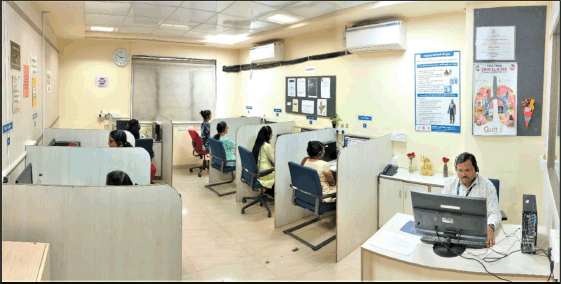
Figure 1. Counsellors attending calls at NTQLS Centre, Mumbai.
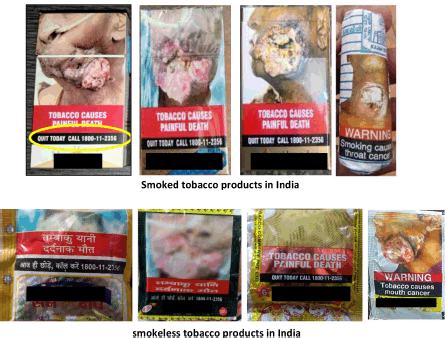
Figure 2. Statutory warning and tobacco quit line toll-free number on smoke and smokeless tobacco products in India.
There are immediate and long-term benefits to quitting tobacco at any age. An example of the immediate effect of tobacco quitting involves improved lung function, heart rate and drop in blood carbon monoxide level within 2–12 weeks of quitting tobacco, while in a year; the risk of coronary heart disease is reduced to half as compared to tobacco users [10].
Tobacco quitting requires tackling at various levels of behavioural intervention. The NTQLS harnesses the potential of inducing behavioural modification through telephonic counselling to help people quit tobacco. NTQLS provides a service that can be accessed from anywhere, free of cost and provides a feasible option to quit tobacco [9].
However, there are several factors known to influence tobacco quitting. These include a lack of social support, motivation or knowledge about the harmful effects of its use and addiction. These factors may vary with the region and the population concerned [11–15]. Literature from Indian studies to understand the predictors of tobacco cessation gives mixed findings [3, 15–18]. A study by Shaikh and Saikia [3] finds that low-wealth asset scores had higher odds of tobacco quitting while this is opposed to Srivastava’s finding [15] where a significant association of tobacco quitting with socioeconomic status (SES) was seen. A higher quitting was observed among the male gender, higher levels of education and those belonging to the higher wealth quintile. Corsi et al [16] state the odds of tobacco quitting were higher in females as compared to males. While Nargis et al [17] did not find any significant association between SES and tobacco cessation.
Thus, a thorough understanding of the social, economic and habitué factors is essential to plan and implement interventions [2, 15, 19, 20]. The paper aims to present the data of tobacco quitters who quit tobacco through NTQLS, TMC Mumbai in the year 2021–2022 and factors that influenced tobacco quitting.
Methodology
Area covered
The NTQLS, TMC Mumbai is allotted three states; Maharashtra, Gujarat and Goa and three Union territories (UTs); Lakshadweep, Daman and Diu, Dadra and Nagar Haveli. However, it received calls from other Indian states and UTs. According to NTQLS, TMC Mumbai report, in 2021 and 2022, the majority of the quitters were callers from Maharashtra (59.7%) followed by Gujrat (20.4%), Rajasthan (7%) and Uttar Pradesh (4.7%) [21].
Infrastructure and training
As it is a telephone-based service, a separate telephone primary rate interface line from Mahanagar Telephone Nigam Limited was procured. The telephone was mapped with the national toll-free number 1800-11-2356 and 9 computers were installed with one server. Call centre software was procured and installed on all the computers. Infrastructure has the furniture and other essential items with dedicated office space.
The selected staff was trained by the senior faculty at CCE-TMC for 2 weeks on tobacco hazards, behaviour change and quitline protocol. For acquainting the staff with the quitline working, they were deputed to VPCI, Delhi. Currently, there are 16 counsellors and two supervisors working in two shifts at NTQLS, TMC Mumbai [21]. NTQLS, TMC Mumbai sensitized virtually the Maharashtra state government officials, the public health officers and Primary Health Centre staff regarding the availability of quitline service provided.
The telephonic counselling at NTQLS is provided by trained counsellors using the WHO protocol of telephone counselling. It is a 15–30-minute counselling session and regular follow-up based on 5 A’s (Ask, Advise, Assess, Assist and Arrange) and 5R’s (Relevance, Risks, Rewards, Roadblocks, Repetition) [22]. Quitline services provide tobacco cessation services for both smoked and smokeless tobacco [23]. Regular quality control of the calls of the quitters is performed by the senior supervisor of NTQLS, TMC Mumbai. An independent evaluation of the NTQLS, TMC Mumbai was done by the Post Graduate Institute of Medical Education and Research, Chandigarh, India, through WHO and MoHFW, India [24]. The purpose of the evaluation was to assess the caller characteristics, caller satisfaction, cost-effectiveness of NTQLS and service monitoring of the NTQLS centres in India. The findings of the evaluation reported that NTQLS, Mumbai, was adhering to the standard protocols and service provision was satisfactory [24].
Call structure and call sequence
The call structure is described in the NTQLS report [9]. The person willing to quit tobacco calls on the toll-free number. The caller is greeted with an automated interactive voice response for language selection through which the system interacts with callers and leads them to the available counsellor.
The first call made by the caller to NTQLS is called the ‘Fresh call’. This call is answered by the counsellor who briefs the caller about the process and the services provided by NTQLS. Since it is a telephone conversation, the counsellor takes verbal consent from the caller and specifies that the data collected will be confidential and will be used for research purposes only. The caller’s details are retrieved and recorded only after his/her verbal consent.
During the ‘Fresh call’, information regarding tobacco use and other sociodemographics of the caller is noted. Based on the caller’s readiness (assessed by the counsellor during the fresh calls to check the willingness of the caller to quit tobacco), a quit date is set by the counsellor. The set quit date is the 7th day after the Fresh call. The caller is guided to quit the tobacco with the help of behavioural modification to deal with the triggers for tobacco consumption, withdrawal symptoms and precautionary measures to prevent relapse. The details of the topics covered during the calls are mentioned elsewhere [9].
The next call is a reminder call or ‘P1 call’, made by the counsellor to the caller 2 days before the set quit date. The counsellor questions the caller regarding the gradual reduction of tobacco use, whether the caller is following the remedies suggested by the counsellor to quit tobacco, triggers, withdrawal symptoms, cravings, hindrances to quit and counsels accordingly, therefore, preparing the caller for the quit date.
The next call is a ‘P2 call’ or ‘Quit date call’ made by the counsellor on the set quit date agreed upon by the caller. Any issues or problems faced by the caller regarding quitting tobacco are discussed. During this call, if the caller confirms quitting tobacco (complete abstinence from all forms of tobacco); only then his/her status of tobacco quitting is considered as ‘Quit’; however, the caller is not yet declared as a ‘Quitter’.
If the caller is unable to quit on the set quit date, an extended quit date is set by the counsellor again and ‘P2 calls’ are made again.
The next call is the ‘P3 call’ which is the follow-up call made after 1 week by the counsellor to those confirmed to quit tobacco during the ‘P2 call’. This is to check whether or not the caller is maintaining his/her ‘Quit’ status confirmed during the P2 call.
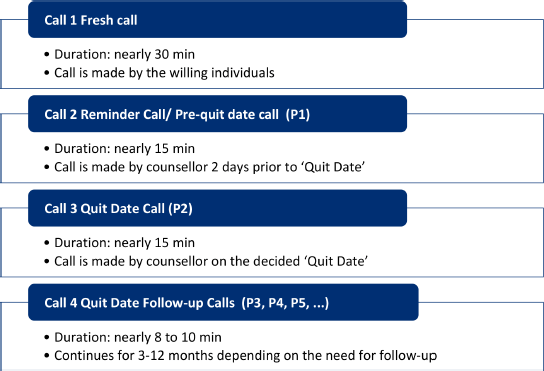
Figure 3. Call sequence at NTQLS centre, Mumbai.
The next follow-up call is the ‘P4 call’, which is made 1 week after the P3 call. This is to check whether the caller is continuing to abstain from tobacco. If the caller has successfully stayed quiet since the quit date, only then he/she is declared a quitter during the P4 call.
After this, the follow-up calls from P5 to P8 are made after every 3 months, respectively. The callers continuing to stay quit at P4; that is complete abstinence from all forms of tobacco declared as tobacco quitters.
The progress of these calls is recorded on the progress sheet. The follow-up continues for around 6–12 months post-quitting of the caller. Despite the follow-up calls, few callers might relapse and some are lost to follow-up. The callers that relapse at any stage are transferred to P2 calls, where the quit date is set and the quitting journey begins again. The call sequence is illustrated in Figure 3.
Data collection process and tools used
For the study, we have used the data of the quitters at the P4 stage for the years 2021 and 2022. The data were abstracted from the call centre software into Microsoft Excel. The data were cleaned and checked by the senior staff for validity and further analysis was conducted using STATA version 15. All the data quality measures were implemented.
Statistical analysis
A univariate analysis was conducted and those variables that were significantly associated were put in a multiple logistic regression analysis to identify potential predictors of tobacco quitting. Tobacco quitting is a dependent variable and the independent variable consists of factors such as the caller’s sociodemographic characteristics, tobacco consumption habits, previous quit attempts, alcohol consumption, other substance use and co-morbidity. The confounders were identified and adjusted during regression. Odds are given in terms of the likelihood of quitting tobacco at a 95% confidence interval (CI).
Results
In the years 2021–2022, the total number of calls that hit the system was 448,893, and out of these, 127,163 (28.3 %) were calls attended. In these years, out of the total attended calls, a quit date was set for 21,504 calls (16.9%), and out of these, 8,276 (38.5%) callers quit tobacco. The details are illustrated in Figure 4. Table 1 illustrates the age distribution of the calls for which the quit date was set. The majority of the calls for which the quit date was set belonged to the 25–34 age group 39.3% while about 1/3rd of it belonged to the age group 18–24.
Out of the total observations of 8,276 tobacco quitters, there was missing information on some of the study variables for 1,641 observations. These 1,641 observations were excluded from the study and statistical analyses were done for the 6,635 common observations of tobacco quitters.
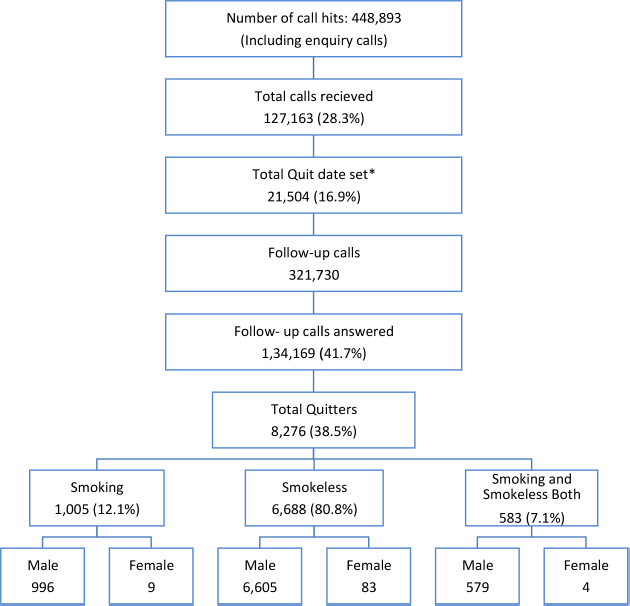
Figure 4. Number of calls received, quit date set and quitters at NTQLS Centre, TMC Mumbai (2021–2022). *Quit date include the ones that were set only in the year 2021–2022 and the previous year’s set quit date is not included.
Table 1. Age distribution of the calls for which the quit date was set.
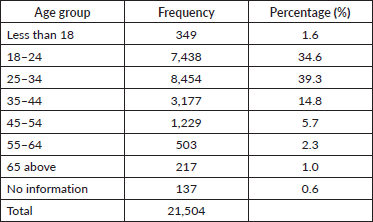
Frequency distribution is presented for 8,276 quitters irrespective of missing information. Table 2 gives the percentage distribution of the quitters and non-quitters for the year 2021–2022. Quitters are the number of tobacco users that quit tobacco in the years 2021–2022, while non-quitters include the ones who could not quit tobacco or relapsed in the year 2021–2022 irrespective of the timeframe in which the quit date was set. For example; non-quitters also include callers for whom the quit date was set in 2020 but found to be relapsed or could not quit during follow-up calls made in the years 2021–2022.
Out of the total 8,276 quitters, 75.6% were aged below 35 and 98.9% quitters were male. Of the total quitters, 35% were drivers/farmers/labourers by profession and 75.7% had a monthly income of less than Indian Rupees (INR) 30,000/-.
For the tobacco consumption habits, 80.8% were smokeless tobacco quitters. A total of 42.4% had a history of using tobacco for up to 10 years, 53.5% used tobacco within 5 minutes of waking up, 43.7% consumed tobacco more than 10 units/packets a day and 74.3% had previous tobacco quit attempts. Of the tobacco quitters, 77.5% did not consume alcohol, 76.6% had no history of substance use and 59% of the quitters had no known co-morbidities.
A multiple logistic regression model was fitted on 6,635 common observations to obtain the factors influencing tobacco quitting. The findings from the multiple logistic regression are illustrated in Table 3.
Interpretation
Gender
Female callers were 41% less likely (OR: 0.59, 95% CI: 0.35–0.99) to quit tobacco as compared to male callers.
Occupation
People working in the private sector were 30% less likely (OR: 0.70, 95% CI: 0.61–0.81) to quit tobacco than drivers/farmers/labourers.
Duration of tobacco use (In years)
Compared to those who used tobacco for up to 10 years, people who used tobacco for more than 10 years were 15% less likely (OR: 0.85, 95% CI: 0.73–0.97) to give up the habit.
Duration of tobacco use on waking up (In minutes)
Individuals who consume tobacco within 6–30 minutes (OR: 1.29, 95% CI: 1.12–1.49) and 30–60 minutes after waking up (OR: 1.26, 95% CI: 1.05–1.51) in the morning have a 29% and 26% higher quitting rate, respectively, as compared to those who were consuming it within 5 minutes of waking.
Table 2. Percentage distribution of quitters and non-quitters for year 2021–2022 at NTQL centre, TMC Mumbai.
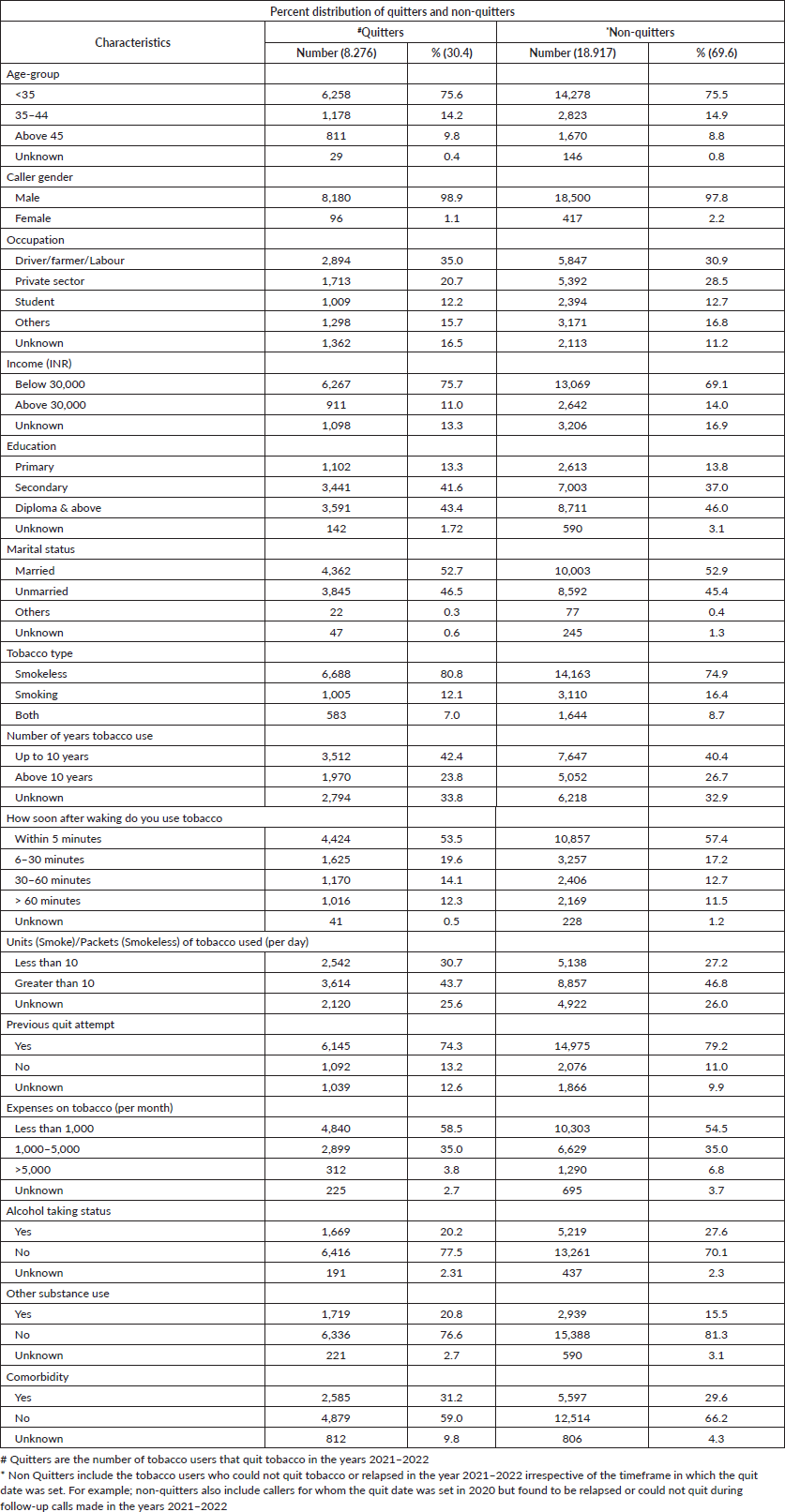
Table 3. Multiple logistic regression model identifying the factors influencing tobacco quitting among callers at NTQLS, Mumbai for the years 2021–2022.
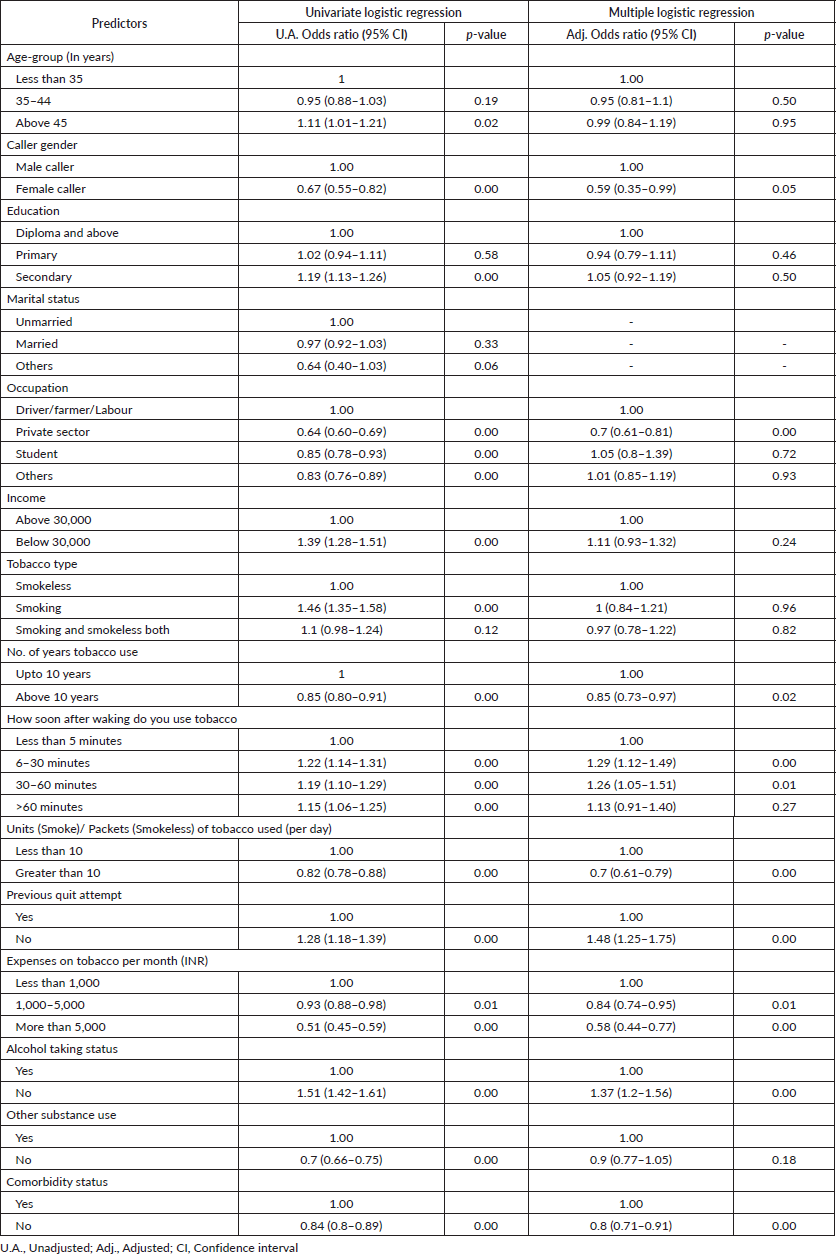
Number of tobacco units (smoked) or packets (smokeless) consumed per day
Those individuals who consumed more than 10 units/packets of tobacco per day were 30% less likely (OR: 0.70, 95% CI: 0.61–0.79) to quit than those who consumed less than ten tobacco pieces per day.
Previous quit attempt
Individuals with no previous tobacco quit attempt had a 48% (OR: 1.48, 95% CI: 1.25–1.75) higher quit rate than those attempting to quit tobacco at least once.
Monthly expenditure on tobacco
Callers who were spending more than INR 5,000 per month on tobacco were 42% (OR: 0.58, 95% CI: 0.44–0.77) less likely to quit tobacco than those who were spending less than INR 1,000 per month on tobacco.
Alcohol consumption
As compared to the individuals who consumed alcohol, the individuals who never consumed alcohol were 37% more likely (OR: 1.37, 95%CI: 1.2–1.56) to quit tobacco.
Pre-existing co-morbidity
Callers who did not have a known co-morbid condition have a 20% lower quitting rate as compared to those with co-morbid conditions (OR: 0.8, 95% CI: 0.71–0.91).
Discussion
The objective of the study is to present the call attended by NTQLS Mumbai and understand the factors influencing the process of tobacco quitting that are fulfilled by the results. This shows that NTQLS, TMC Mumbai play an important role in tobacco control and help in identifying the factors that serve as determinants for tobacco quitting. The findings reflect that in the years 2021–2022, a total of 448,893 calls hit the system. Of these, 127,163 (28.3 %) calls were attended. Of the attended calls, a quit date was set for 21,504 calls (16.9%); of these, 8,276 (38.5%) callers quit tobacco. This shows that people are eager to utilise the services considering we have received over 0.45 million calls in the year 2021–2022 of which only around 30% of the calls could be attended. Of the attended calls, 1 out of 6 people agreed to take counselling and of the people agreeing to the counselling, 1 in 3 people quit tobacco [21]. This reflects that calls hitting the system are high but there is limited infrastructure and manpower to cater to the increasing demand of the population. To meet the increased demand for quit line services there is a need to strengthen the workforce at quit line centres as well as the services provided. Additionally, to expand the tobacco cessation services, an integrative approach can be employed through the linkage of the NTQLS and the tobacco cessation clinics under the National Tobacco Control Programme at the district level which aims to facilitate free pharmacotherapy and counselling services for tobacco cessation [7]. The study results show the odds of factors influencing tobacco quitting. Individuals with previous quit attempts, who never consumed alcohol, consumed tobacco within 6–30 minutes and 30–60 minutes after waking up had higher quitting rates. While, female callers, private sector workers, individuals consuming more than ten tobacco units/packets, tobacco used for more than 10 years, expenditure of more than 5,000 rupees on tobacco and those with no known co-morbid conditions were less likely to quit tobacco.
Female callers show a lesser tendency to quit tobacco as compared to male callers. As per our experience from NTQLS, Mumbai, this can be attributed to the low awareness among females regarding quitline services, social stigma, busy schedules and lack of dedicated personal time. Our study results for gender variable were in accordance with the study conducted using GATS India (2009–10) [15] where a significant association was found with male gender and GATS 2016 Ethiopia data [18] stating that women were less successful in quitting tobacco. However, a study in Andhra Pradesh found contrasting results with women having higher quitting than males [16].
A study to assess caller characteristics based on the data from Korean Tobacco Cessation Service found that women prefer cessation services that are web or telephone-based to ensure more privacy [25]. A study by Li and Okamoto [26] highlighted social stigma as a main barrier for women to access these services; as women are mostly reluctant to disclose their habit of tobacco consumption therefore facing difficulty in tobacco quitting. A study conducted in the Netherlands found the main barrier for women in quitting tobacco is psychological as it involves emotion and stress as compared to environmental factors seen in men such as second-hand smoke and peer pressure. Another explanation that the study highlighted was women’s physical nicotine dependency. Physical nicotine dependency was lower in women than men but women tend to have higher behavioural and mental nicotine dependency [27]. Studies have also stated hormonal changes throughout the menstrual cycle have an impact on tobacco quitting in women [28]. Women also tend to metabolize nicotine faster than men; therefore, the standard dose of nicotine replacement therapy does not work as effectively in women as it does in men [27].
In the present study, drivers/farmers/labourers have a high quitting rate as compared to private sector callers. It can be due to work-related stress experienced by the private sector workers making it difficult for them to quit tobacco. A study has observed that among corporate sector workers, their exposure to second-hand smoke and peer pressure are the major reasons that make tobacco quitting difficult among private sector workers [29].
For tobacco consumption habits and tobacco dependency, it is seen that callers who consumed tobacco for less than 10 years are more willing to quit as compared to those who consumed it for more than 10 years. Data shows that callers who use tobacco within 30–60 minutes of waking up have a high quit rate as compared to individuals who use tobacco less than 5 minutes after waking up which indicates that individuals having a high dependency on tobacco have a lesser quitting rate. These results are as per the study conducted using GATS India 2016 data [18], and studies conducted in Qatar [11] and China [30].
In the present study, the callers who consume up to ten tobacco units/packets consumption per day have a higher rate of quitting than those who consume more than ten units/packets of tobacco. This finding is in line with the findings of the studies by Li et al [31] and Myung et al [32]. Both these studies highlight that fewer units of tobacco consumption per day indicate that the smoker is minimally dependent on nicotine, thus making it easier to quit [31–33].
Individuals attempting to quit tobacco for the first time have almost 50% higher quit rates than those who have tried to quit before. These results pertaining to tobacco dependency are contradictory to the study conducted in the smoking clinic of a northeastern Malaysian public hospital [33] and similar to the study in Qatar [11]. It was found that those who previously made a tobacco quitting attempt and could not accomplish it perceived themselves as a failure. This also impacted their future quitting intentions. On the other hand, first-time quitters are highly driven and motivated which helps them quit tobacco easily as compared to their counterparts [11].
Our study shows those people who are spending less than Indian Rupees INR 1,000 (~12 USD) have a higher quit rate than those who are spending more than INR. 1,000 (~12 USD). Higher expenditure was shown to higher dependency on tobacco, thus making it difficult to quit tobacco. Saving money was also listed as one of the reasons to quit tobacco [34].
Individuals who have no other addiction like alcohol with tobacco have almost 40% higher quitting rate than those who are consuming alcohol as well. Callers having co-morbid disorder have around 20% higher quitting rate as compared to those with no co-morbid disorder. Those having other addictions to tobacco, such as alcohol were more likely to face adverse health effects due to tobacco. This was aggravated by the presence of co-morbidities. Such individuals perceive health as a major priority thus helping them to quit tobacco as compared to their counterparts who perceive smoking as a mere threat to their health [33].
To summarize, it was observed that the caller’s gender, occupation, number of tobacco units/packets used, tobacco dependency, expenditure on tobacco, previous quit attempts, alcohol/substance use and co-morbidities are the factors that influence tobacco quitting. Reflecting on the findings of the study, the NTQLS, TMC Mumbai centre must emphasize the factors significant to females and provide additional stress-relieving advice to private sector callers. A rigorous and tailor-made counselling plan with additional efforts should be undertaken to counsel callers with high tobacco dependency, those with high expenditure on tobacco, those consuming alcohol with tobacco and those with pre-existing co-morbid conditions.
Based on the aforementioned finding, NTQLS, Mumbai provides the following recommendation;
- These variables should be considered during call assessment by the counsellors, where those with callers’ characteristics being predictive of quitting tobacco easily shall be identified and targeted by the counsellor.
- Similarly, a different counselling strategy with an increased dedicated counselling time should be provided to those callers with characteristics not predictive of tobacco quitting.
- The counsellors can also help the caller to connect with the nearest government district centre that provides necessary medical help in tobacco cessation.
- In addition to this, with the consent of the caller his/her family member or next of kin whom the caller trusts; can also be counselled about the necessary support provided to the caller during his/her tobacco-quitting journey. This helps in enhancing social support and making the environment helpful to quit tobacco [35].
NTQLS is a freely available, easy-to-access and convenient service that individuals willing to quit tobacco can utilise without any barrier to the physical location of the individual. This also helps in avoiding the stigma that individuals face when attempting to quit tobacco. Importantly, for cessation counselling one of the barriers encountered was that pertaining to language; thus, impeding the adherence of the individuals to tobacco cessation [36, 37] however NTQLS provides counselling to the individual in the local language or the language with which the individual is comfortable.
Tobacco-related risk factors are highly prevalent in LMICs [38]. Being one of the leading risk factors of NCDs worldwide contributing to premature mortality, tobacco consumption directly impedes the progress of the SDGs (SDG 3.4) [39]. The Southeast Asia region accounts for 81% of the world’s smokeless tobacco users and 1/3rd of the world’s school children 13–15 years using tobacco are from this region [40].
To tackle this region-specific burden of tobacco, the Dili Declaration on Tobacco Control was adopted at the 68th Session of the South-East Asia Regional Committee. To contain the growing tobacco epidemic, a political commitment was made to develop, strengthen, implement and accelerate evidence-based tobacco control policies at the country level. It is specially focused on challenges posed by smokeless tobacco and electronic nicotine delivery systems [40].
Cessation services are crucial to alleviate tobacco use and quitline serves as a standard for tobacco cessation [41]. In 2018, tobacco quitline services were available in 66 countries [42]; however, the Association of Southeast Asian Nations countries still have limited facilities that provide tobacco cessation support [43]. Considering the need to strengthen tobacco cessation services in the Southeast Asia region [44], NTQLS, TMC Mumbai India can serve as a training hub in providing support to strengthen the cessation services in the region.
Strengths and limitations
The study highlights the factors influencing tobacco quitting, incorporating the sociodemographic characteristics as well as variables of tobacco consumption habits along with details of substance use, alcohol consumption and existing co-morbidities. There is a need for such services
The limitation of the study is that the study is based on a selected sample of people who quit tobacco through NTQLS, TMC Mumbai. The callers are confirmed as quitters on a telephonic conversation with the counsellor; therefore, there is a possibility of reporting bias.
Conclusion
The study highlights the predictors of tobacco quitting. These predictors will be emphasized and considered while planning the counselling strategy for the callers. This will improve the quality of the tailor-made, caller-specific counselling strategy used to help the caller quit tobacco. We observed that there is an increase in the demand for quitline services. Thus, the quitline service and its workforce must be strengthened. These findings will help in developing interventions that will yield better outcomes. A strong foundation of counselling and additional tailored interventions focusing on significant predictors can bring the end goal of NTQLS of tobacco control to fruition.
List of abbreviations
CCE, Centre for Cancer Epidemiology; GATS, Global Adult Tobacco Survey; LMIC, Low-and middle-income countries; MoHFW, Ministry of Health and Family Welfare; NCD, Noncommunicable disease; NTQLS, National Tobacco Quitline Services; SDG, Sustainable Development Goals; TMC, Tata Memorial Centre; VPCI, Vallabhbhai Patel Chest Institute; WHO, World Health Organisation.
Acknowledgments
The authors gratefully acknowledge the financial support provided by the Tobacco Control Division and the MoHFW, Government of India, to run the NTQLS effectively at TMC, Mumbai. The authors acknowledge Dr Sudeep Gupta (Director, TMC) for supporting tobacco quitline services and Dr Rajesh Dikshit (Director, CCE-TMC) for providing administrative support to the project.
Conflicts of interest
No potential conflict of interest was reported by the author(s).
Funding
NTQLS, TMC Mumbai receives financial aid from the Tobacco Control Division, MoHFW, Government of India, New Delhi.
Statement of ethical compliance
This was a service-based project where verbal informed consent was taken through telephone from the caller. Caller-related information collected during routine calls was de-identified during the data analysis and manuscript preparation; therefore, ethical approval for this manuscript was not required.
Author contributions
AB: conceptualisation, methodology, writing, editing, critical reviewing, overall supervision; SM: Writing, editing, data management, literature review; SB: Writing, editing, data management; PC: Writing, editing, data management; GO: counselling and data collection; RS: counselling and data collection; MY: counselling and data collection; SS: quality control of counselling, data quality assurance, data management; SG: quality control of counselling, data quality assurance, data management; PC: critical review of the manuscript, technical guidance, overall supervision.
References
1. World Health Organization (2023) Tobacco: Key Facts (Geneva: World Health Organization) [https://www.who.int/news-room/fact-sheets/detail/tobacco] Date accessed: 22/08/23
2. Nair V, Mallya SD, and Pandey AK, et al (2023) Determinants of quit attempts among current Indian tobacco users: findings from global adult tobacco survey, 2016-17 Clin Epidemiol Glob Health 23 101366 https://doi.org/10.1016/j.cegh.2023.101366
3. Shaikh R and Saikia N (2022) Socioeconomic inequalities in tobacco cessation among Indians above 15 years of age from 2009 to 2017: evidence from the Global Adult Tobacco Survey (GATS) BMC Public Health 22(1) 1419 https://doi.org/10.1186/s12889-022-13820-7 PMID: 35883171 PMCID: 9321312
4. World Health Organization (2023) Tobacco Use Falling: WHO Urges Countries to Invest in Helping More People to Quit Tobacco (Geneva: World Health Organization) [https://www.who.int/news/item/16-11-2021-tobacco-use-falling-who-urges-countries-to-invest-in-helping-more-people-to-quit-tobacco] Date accessed: 22/08/23
5. National Health Mission (2016) GATS-2 Global Adult Tobacco Survey Fact Sheet India 2016-17 [https://ntcp.nhp.gov.in/assets/document/surveys-reports publications/GATS-2-FactSheet.pdf] Date accessed: 27/12/21
6. Kumar R, Saroj SK, and Kumar M (2021) Tobacco quitline toll-free number on tobacco packets in India: an analysis on outcome Monaldi Arch Chest Dis 91(2) https://doi.org/10.4081/monaldi.2021.1612
7. National Tobacco Control Programme-National Tobacco Quitline Services (New Delhi: Ministry of Health and Family Welfare) [https://ntcp.mohfw.gov.in/national_tobacco_quit_line_services] Date accessed: 02/12/23
8. Reddy BRC, Musale D, and Kadam D, et al (2023) Challenges faced by tobacco quitline services during the COVID-19 pandemic J Subst Use 29(3) 376–381 https://doi.org/10.1080/14659891.2023.2167744
9. Tobacco Quitline Centre (2020) First-Year Report – 2019 (Mumbai: Tata Memorial Centre)
10. Tobacco: health benefits of smoking cessation [Internet] (2023) [https://www.who.int/news-room/questions-and-answers/item/tobacco-health-benefits-of-smoking-cessation] Date accessed: 28/07/24
11. Al-Dahshan A, Al Muraikhi H, and Musa S, et al (2023) Prevalence and predictors of smoking cessation among smokers receiving smoking cessation intervention in primary care in Qatar: a 6-month follow-up study Front Public Health 11 1166016 https://doi.org/10.3389/fpubh.2023.1166016 PMID: 37275499 PMCID: 10235512
12. Agarwal D, Kumar A, and Manjunath BC, et al (2022) Determinants for tabacco cessation amongst smokers visiting tertiary health care centre in India Przegl Epidemiol 76(4) 495–502 https://doi.org/10.32394/pe.76.46 PMID: 37017216
13. Dhumal GG, Pednekar MS, and Gupta PC, et al (2014) Quit history, intentions to quit, and reasons for considering quitting among tobacco users in India: findings from the Tobacco Control Policy Evaluation India Wave 1 Survey Indian J Cancer Suppl 1(01) S39–S45 https://doi.org/10.4103/0019-509X.147467
14. Binnal A, Rajesh G, and Ahmed J, et al (2013) Insights into smoking and its cessation among current smokers in India Asian Pac J Cancer Prev 14(5) 2811–2818 https://doi.org/10.7314/APJCP.2013.14.5.2811 PMID: 23803036
15. Srivastava S, Malhotra S, and Harries AD, et al (2013) Correlates of tobacco quit attempts and cessation in the adult population of India: secondary analysis of the Global Adult Tobacco Survey, 2009-10 BMC Public Health 13 263 https://doi.org/10.1186/1471-2458-13-263
16. Corsi DJ, Subramanian SV, and Lear SA, et al (2014) Tobacco use, smoking quit rates, and socioeconomic patterning among men and women: a cross-sectional survey in rural Andhra Pradesh, India Eur J Prev Cardiol 21(10) 1308–1318 https://doi.org/10.1177/2047487313491356
17. Nargis N, Yong HH, and Driezen P, et al (2019) Socioeconomic patterns of smoking cessation behavior in low and middle-income countries: emerging evidence from the global adult tobacco surveys and International Tobacco Control Surveys PLoS One 14(9) e0220223 https://doi.org/10.1371/journal.pone.0220223 PMID: 31490958 PMCID: 6730869
18. Gawde NC and Quazi Syed Z (2023) Determinants of quit attempts and short-term abstinence among smokers in India: global adult tobacco survey, 2016-17 Asian Pac J Cancer Prev 24(7) 2279–2288 https://doi.org/10.31557/APJCP.2023.24.7.2279 PMID: 37505757 PMCID: 10676471
19. Demissie HS, Smith T, and de Quevedo IG, et al (2022) Factors associated with quit attempt and successful quitting among adults who smoke tobacco in Ethiopia: global adult tobacco survey (GATS) 2016 Tob Prev Cessat 8 12 https://doi.org/10.18332/tpc/146170 PMID: 35350770 PMCID: 8915294
20. Luu NM, Tran TTH, and Luong NK, et al (2023) Smoking cessation, quit attempts and predictive factors among Vietnamese adults in 2020 Asian Pac J Cancer Prev 24(5) 1701–1710 https://doi.org/10.31557/APJCP.2023.24.5.1701 PMID: 37247291 PMCID: 10495881
21. Budukh A, Lanjekar K, and Karande Y, et al (2023) Annual Report of Tobacco Quitline Centre (2021-2022), Tata Memorial Centre, Mumbai, India
22. World Health Organization (2014) Toolkit for Delivering the 5A’s and 5R’s Brief Tobacco Interventions in Primary Care (Geneva: World Health Organization) p 16 [https://apps.who.int/iris/handle/10665/112835] Date accessed: 27/08/23
23. Singh A, Budukh A, and Chaturvedi P, et al (2019) Systematic review on telephonic quitline and its effects on smokeless tobacco IJNCD 4(3) 65–72
24. PostGraduate Institute for Medical Education and Research (2023) Evaluation of National Tobacco Quitline Services. Final Report submitted to Ministry of Health and family Welfare, Government of India Internal Report
25. Jeong BY, Lim MK, and Yun EH, et al (2019) User characteristics of national smoking cessation services in Korea: who chooses each type of tobacco cessation program BMC Health Serv Res 19 14 https://doi.org/10.1186/s12913-018-3817-z]
26. Li M and Okamoto R (2020) Gender differences and smoking cessation in the Japanese smoking cessation treatment program Tob Induc Dis 18 1–2 https://doi.org/10.18332/tid/128497
27. Dieleman LA, van Peet PG, and Vos HMM (2021) Gender differences within the barriers to smoking cessation and the preferences for interventions in primary care a qualitative study using focus groups in The Hague, The Netherlands BMJ Open 11 e042623 https://doi.org/10.1136/bmjopen-2020-042623 PMID: 33514579 PMCID: 7849885
28. Allen SS, Bade T, and Center B, et al (2008) Menstrual phase effects on smoking relapse Addiction 103(5) 809–821 https://doi.org/10.1111/j.1360-0443.2008.02146.x PMID: 18412759 PMCID: 4519081
29. Kulkarni PS, Parkar SR, and Kate N, et al (2018) Role of personality in tobacco smoking behavior in corporate sector: a cross-sectional study Ind Psychiatry J 27(1) 103–109 https://doi.org/10.4103/ipj.ipj_46_16 PMID: 30416300 PMCID: 6198598
30. Lin B, Xie L, and Xie X, et al (2023) Predictors for quitting smoking in smoking cessation clinics among female smokers in China Tob Induc Dis 21 26 https://doi.org/10.18332/tid/159132 PMID: 36819959 PMCID: 9936604
31. Li L, Borland R, and Yong HH, et al (2010) Predictors of smoking cessation among adult smokers in Malaysia and Thailand: findings from the International Tobacco Control Southeast Asia Survey Nicotine Tob Res 12(Suppl 1) S34–S44 https://doi.org/10.1093/ntr/ntq030 PMID: 20889478 PMCID: 2948135
32. Myung SK, Park JG, and Bae WK, et al (2008) Effectiveness of proactive quitline service and predictors of successful smoking cessation: findings from a preliminary study of quitline service for smoking cessation in Korea J Korean Med Sci 23(5) 888–894 https://doi.org/10.3346/jkms.2008.23.5.888 PMID: 18955799 PMCID: 2580017
33. Mohammad NI, Ghazali S, and Shafei MN (2018) Predictors of successfully quitting smoking among smokers registered at the quit smoking clinic at a public hospital in northeastern Malaysia Fam Med Community Health https://doi.org/10.15212/FMCH.2018.0123
34. Takada M, Tabuchi T, and Iso H (2022) Percentage of income spent on tobacco and intention to quit: a cross-sectional analysis of the JASTIS 2020 study Environ Health Prev Med 27 46 https://doi.org/10.1265/ehpm.22-00103 PMID: 36464319 PMCID: 9761199
35. Dwivedi S, Aggarwal A, and Singh N, et al (2013) Role of family milieu in tobacco addiction: a study in a tertiary-care institution in India J Health Popul Nutr 31(1) 130–132 https://doi.org/10.3329/jhpn.v31i1.14757 PMID: 23617213 PMCID: 3702367
36. Hooper MW, Payne M, and Parkinson KA (2017) Tobacco cessation pharmacotherapy use among racial/ethnic minorities in the United States: considerations for primary care Fam Med Community Health 5
37. Taylor SP, Nicolle C, and Maguire M (2013) Cross-cultural communication barriers in health care Nurs Stand 27(31) 35–43 https://doi.org/10.7748/ns2013.04.27.31.35.e7040 PMID: 23641636
38. Theilmann M, Lemp JM, and Winkler V, et al (2022) Patterns of tobacco use in low- and middle-income countries by tobacco product and sociodemographic characteristics: nationally representative survey data from 82 countries BMJ 378 e067582 https://doi.org/10.1136/bmj-2021-067582
39. Gupta R, Bhatt G, and Goel S, et al (2023) Prioritizing tobacco control & its cessation under sustainable development goals with a focus on India Indian J Med Res 157(5) 381–385 https://doi.org/10.4103/ijmr.ijmr_3030_21 PMID: 37955214 PMCID: 10443723
40. World Health Organization (2023) Tobacco Control in the South-East Asia Region (Geneva: World Health Organization) [https://www.who.int/southeastasia/health-topics/tobacco/tobacco-control-in-the-south-east-asia-region] Date accessed: 04/12/23
41. Brady BR, Nair US, and Gerald JK, et al (2019) Higher quality quit-date goal setting enhances quit attempts among quitline callers Tob Prev Cessat 5 20 https://doi.org/10.18332/tpc/109537
42. Kreuter MW, Garg R, and Fu Q, et al (2023) Helping low-income smokers quit: findings from a randomized controlled trial comparing specialized quitline services with and without social needs navigation Lancet Reg Health Am 23 100529 PMID: 37408953 PMCID: 10319314
43. Amul GGH and Pang T (Pangestu) (2018) The state of tobacco control in ASEAN: framing the implementation of the FCTC from a health systems perspective Asia Pac Policy Stud 5(1) 47–64 https://doi.org/10.1002/app5.218
44. Iqbal S, Barolia R, and Petrucka P, et al (2022) Smoking cessation interventions in South Asian Region: a systematic scoping review BMC Public Health 22(1) 1096 https://doi.org/10.1186/s12889-022-13443-y PMID: 35650606 PMCID: 9158221






